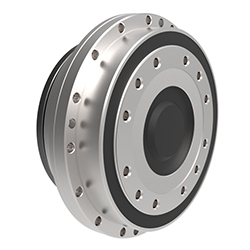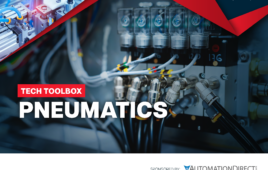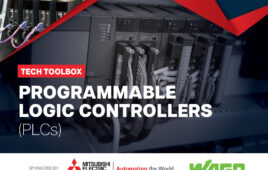Industrial robot arms can have as many as ten articulated joints. Each joint is its own mechanical system with an actuator, drive, gearbox, controller, and other components. Factors like misalignment, imbalance, and field noise create cumulative stress that impacts the precision of end-of-arm tools (EOAT) like grippers and welding torches. The cycloidal and strain wave gearboxes commonly used in articulated robots have inherent vibrations. However, the nature and extent of the vibrations vary, as do the solutions that minimize their impact on EOAT.

Milling spindle attached with robotics arm finishing cuts to housing case. (Source: Adobe)
Where does vibration originate?
An imbalance between rotating parts causes vibration in cycloidal gear systems. Continuous engagement of the cycloid system’s eccentric cam lobes and pins can reduce vibration compared to other gear types.
Traditional servo planetary gearboxes have a balanced mechanical system but are limited for use in high precision applications due to higher backlash compared to cycloidal gearboxes. Structural design can compensate for vibration but not eliminate it. Additional methods of minimizing vibrations include damping, isolation, lubrication, and active control systems.
Backlash is a crucial part of precision and a critical gearbox or reducer performance indicator. Too much backlash affects the precision and stability of the gearbox, which adds to vibration and noise. Zero backlash is especially critical to high-precision applications, but achieving it has required trade-offs that compromise torque and speed.
Cycloidal vs planetary gearboxes
Selecting the right gearbox depends on application requirements such as backlash, torsional stiffness, payload capacity, and footprint. Cycloidal and planetary gearboxes offer better performance in different areas. For example, cycloidal has the advantage in impact loading, able to handle 10x its nominal torque in the event of a collision or sudden change of direction. Planetary has the advantage in high torque applications, able to lift heavy loads such as pallets. (See table below.)

How the GPL planetary robotic gearbox works
GAM’s GPL planetary robotic gearbox offers best-on-the-market torsional stiffness and zero backlash throughout the life of the gear, with no adjustments necessary. The GPL’s unique design compensates for wear, allowing it to maintain precision for 20,000 operating hours vs. 6,000 hours for standard cycloidal gearboxes. The balanced planetary gearing, along with the wear compensation, eliminates vibrations while maintaining low backlash less than 6 arcsec.

GPL Series Robotic Planetary Gearbox (Image courtesy of GAM)
Application tip: Robotic welding with trunnion

Robotic welding system. (Source: Adobe)
Planetary gearboxes are ideally suited for welding round metal parts with a trunnion. The main advantage of a very high precision planetary gearbox, such as the GPL, is the superior positional accuracy during the rotation of the gearbox. This allows an operation, such as welding, to be done while the trunnion is rotating, not just in the stopped position at the end of the rotation.
For more information, visit www.gamweb.com.
Filed Under: SPONSORED CONTENT





